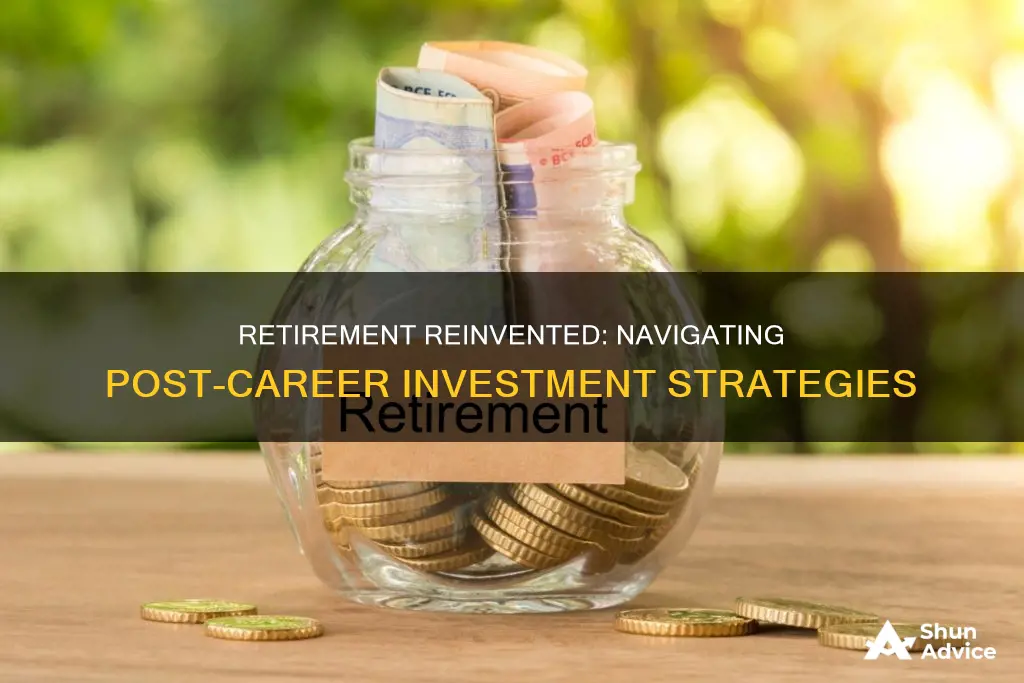
If your mother is retired, there are a number of ways she can invest her money. It's important to first consider her risk tolerance and capacity, as well as her income requirements. If she doesn't need additional income, a conservative approach is best, investing around 50% of her money in equity and the rest in fixed income. If she does need additional income, a government-backed guaranteed vehicle will provide a steady income without uncertainty.
There are several low-risk investment options for retirees, including money market funds, high-dividend blue-chip stocks, bank certificates of deposit, and fixed index annuities. For those seeking higher returns, a 60/40 mix of stocks and bonds can provide an income advantage, or investing in growth and value stocks.
| Characteristics | Values |
|---|---|
| Investment options | Target-date funds, 401(k)s, IRAs, stocks, bonds, mutual funds, annuities, CDs, high-yield savings accounts |
| Factors to consider | Risk tolerance, age, income requirement, pension, Social Security benefits, expenses, legacy, health insurance, long-term care |
| Steps to take | Have transparent conversations, assess finances and expenses, create a financial plan, consider a financial planner, set up a budget, diversify investments |
What You'll Learn

Pension plans and guaranteed income sources
Traditional Pensions
Traditional pensions are a type of defined benefit plan that is fully funded by employers. They provide a fixed monthly benefit to retirees and are payable for life, usually replacing a percentage of the retiree's pre-retirement income. However, traditional pensions are becoming less common, with fewer companies offering them.
Social Security/Government Benefits
Social Security is a foundational source of income for retirees in the US. The amount received depends on when you start claiming benefits. Claiming early will result in reduced monthly benefits, while delaying claiming past your full retirement age can increase your benefit amount.
In Canada, the Canada Pension Plan (CPP) and Quebec Pension Plan (QPP) are important sources of retirement income for most Canadians. The amount received depends on factors such as age, contribution amount, and eligibility for additional provisions.
Income Annuities
Income annuities are contracts issued by insurance companies that guarantee a set income for life or a specified period. There are several types of income annuities, including immediate income annuities, deferred income annuities, and annuities with a guaranteed lifetime withdrawal benefit (GLWB). Income annuities can provide a pension-like stream of income and help manage longevity risk.
Guaranteed Income Supplements
In Canada, the Guaranteed Income Supplement (GIS) is available to eligible seniors with low income. It provides additional income to supplement Old Age Security (OAS) or other retirement savings.
Employer-Sponsored Retirement Plans
Employer-sponsored retirement plans, such as 401(k) plans in the US and Registered Pension Plans (RPPs) in Canada, allow employees to save for retirement with tax advantages. These plans may include employer matching contributions, further boosting retirement savings.
Pooled Registered Pension Plans (PRPPs)
PRPPs are a type of retirement savings plan available to individuals in Canada who do not have access to a workplace pension plan. PRPPs offer tax advantages and provide a defined contribution plan for retirement savings.
Investing in People: Debt as an Asset
You may want to see also

Risk tolerance and capacity
When it comes to investing, risk tolerance and risk capacity are two crucial concepts that often get confused but have distinct meanings. Here's a detailed overview of these concepts and how they apply to your retired mother's investment strategy:
Risk Tolerance:
Risk tolerance refers to an individual's psychological willingness to take on risk. It is a measure of how comfortable someone is with the uncertainty and volatility associated with different investments. In other words, it's about how much risk an investor is willing to accept within their portfolio. Age, investment goals, and income all contribute to an investor's risk tolerance.
For example, younger investors are generally more willing to take on higher-risk investments, such as stocks, equity funds, and exchange-traded funds (ETFs), as they have more time to recover from potential losses. On the other hand, retirees or those close to retirement age tend to have a lower risk tolerance and prefer more stable, guaranteed investments like bonds, bond funds, income funds, or cash investments.
Risk Capacity:
While risk tolerance is about emotional comfort with risk, risk capacity relates to the financial ability to endure potential losses. It is determined by concrete financial circumstances, such as income, assets, liabilities, debts, insurance coverage, and time horizon. Risk capacity sets a tangible boundary on the level of risk that can be taken, irrespective of an individual's willingness to take on risk.
For instance, someone with a high risk capacity may have a sizable investment portfolio, stable income, limited debt, adequate insurance coverage, and a long time horizon until retirement. Conversely, someone with a lower risk capacity may have limited savings, a fixed income, dependents, and a shorter time horizon, making them less financially able to absorb potential investment losses.
Achieving Harmony Between Risk Tolerance and Capacity:
It's important to note that an individual's risk tolerance and risk capacity may not always align. This discord can lead to investment strategies that are either too stressful for the investor or expose them to unnecessary financial risk. Therefore, achieving harmony between these two aspects is crucial for a sustainable and effective investment plan.
- Self-Assessment and Professional Guidance: Undertake a thorough self-assessment of your risk tolerance and a detailed financial analysis to determine risk capacity. Consulting financial advisors can provide valuable insights and tailored advice.
- Balanced Portfolio Construction: Create a portfolio that respects both your mother's emotional comfort with risk and her financial reality. This may involve diversifying her investments across different asset classes, such as stocks, bonds, and cash, to align with her risk tolerance and capacity.
- Regular Review and Adjustment: The financial landscape and personal circumstances can change over time, so it's important to regularly review and adjust her investment strategy to maintain the balance between risk tolerance and capacity.
- Education: Enhancing your mother's financial literacy and understanding of investment principles can aid in making more informed decisions and aligning her risk tolerance with her risk capacity.
- Diversification: Diversifying her investments across various asset classes, industries, sectors, and geographic regions can be a powerful tool to manage risk and align her risk tolerance with her financial ability to bear losses.
In conclusion, understanding your retired mother's risk tolerance and risk capacity is essential for constructing a well-balanced investment portfolio that aligns with her financial goals and emotional well-being. By following the steps outlined above, she can strive to meet her financial objectives while maintaining peace of mind.
Dutch Investment Apathy
You may want to see also

Budgeting and expenses
Understanding Retirement Phases and Expenses:
According to experts, retirement can be divided into four distinct phases, each with its own financial considerations: pre-retirement (ages 50-62), early retirement (ages 62-70), middle retirement (ages 70-80), and late retirement (80 and up). During the pre-retirement phase, it's essential to assess expected income sources such as pensions or Social Security, as well as expenses, including mortgage payments and major life events like weddings or children's education.
Creating a Retirement Budget:
Start by calculating your mother's expected average monthly costs. Make a comprehensive list of anticipated expenses, including housing, food, healthcare, transportation, and entertainment. Track these expenses for a few months to ensure her budget is realistic and accurately reflects her spending.
Essential vs. Discretionary Expenses:
Retirement expenses can be categorised into essential (must-haves) and discretionary (optional) expenses. Essential expenses typically include household costs, transportation, living expenses, family care, and medical/health costs. Discretionary expenses might cover entertainment, dining out, hobbies, subscriptions, travel, and charitable donations.
One-Time Expenses:
It's also important to plan for one-time or unexpected expenses, such as a child's wedding, emergency home repairs, or long-term care. These costs can significantly impact retirement savings, so it's best to prepare for them in advance.
Healthcare and Insurance Costs:
Healthcare costs tend to increase during retirement, especially in the late retirement phase (80 and up). Include expenses like Medicare premiums, out-of-pocket medical costs, and long-term care insurance in your mother's budget.
Income Sources:
When planning your mother's budget, consider all potential income sources, such as Social Security benefits, rental income, dividends from stocks, and pension plans. These can help cover expenses and reduce the need to withdraw from savings or investments.
Downsizing and Relocation:
Discuss the possibility of downsizing your mother's primary residence or relocating to a more affordable area. This could reduce housing costs and free up funds for other expenses or savings.
Inflation and Cost of Living:
Don't forget to factor in inflation and potential increases in the cost of living. These factors can impact your mother's purchasing power and overall budget.
Taxes:
Remember to include taxes in your mother's budget, such as federal, state, and local income taxes, as well as property taxes if she owns a home.
Monitoring and Adjusting the Budget:
Retirement budgets are not static; expenses and income can change over time. Regularly monitor your mother's expenses and adjust her budget as necessary to ensure it remains realistic and aligns with her financial situation.
Retirement planning can be complex, and it's important to tailor the budget to your mother's specific needs and circumstances. By following these guidelines and seeking further expert advice, you can help your mother make informed financial decisions and ensure a comfortable retirement.
Investing: Hold Off or Dive In?
You may want to see also

Investment options (e.g. stocks, bonds, CDs)
Investment options for your retired mother will depend on her risk appetite, her income requirements, and her overall financial situation. Here are some options to consider:
Stocks and Shares
Stocks can provide a good source of income through dividends. High-dividend blue-chip stocks can offer stability and regular income, and it is possible to find undervalued stocks with above-average dividends. Stocks can also appreciate in value over time, providing the opportunity for capital growth. However, stocks come with higher risk, and your mother could lose money if the stock market falls.
Bonds
Bonds are a lower-risk option than stocks, offering stability and income. Government or municipal bonds are considered a safe investment, as they are backed by the government and have a low default risk. Bond funds can be purchased through fund companies such as Vanguard, Fidelity, and T. Rowe Price.
Bank Certificates of Deposit (CDs)
CDs offer a fixed rate of interest for a specific period, typically with higher interest rates than regular savings accounts. For example, EverBank offers a nine-month CD with a 5.05% annual yield and a $1,000 minimum deposit. CDs can provide a safe and stable investment option, but there may be penalties for early withdrawal.
Money Market Funds
Money market funds are a low-risk investment option, typically offering high credit quality, short maturities, and high liquidity, making it easy to access cash. For example, the Fidelity Money Market Fund offers a 5.02% seven-day SEC yield with no investment minimum.
Target-Date Funds
Target-date funds automatically adjust the allocation of equities and fixed income as the investor approaches their selected retirement year. This can be a hands-off way to invest, outsourcing the decision-making to professionals. However, it may not be suitable for someone who is already retired.
When considering investment options, it is important to assess your mother's financial situation, including her income, expenses, pension, and social security benefits. It is also crucial to understand her risk tolerance and investment goals. Consulting a financial advisor can help determine the most suitable investment strategy for your mother's needs.
Stock Market: Why Don't More People Invest?
You may want to see also

Financial advisors and planners
- Retirement income planning: Understanding your mother's income needs is crucial. An advisor can help assess her current income, including any pensions or Social Security benefits, and determine if she requires additional income from her investments. This will influence the investment strategies employed.
- Risk assessment and management: Risk tolerance and capacity vary with individuals. Advisors help assess your mother's risk profile, considering factors such as age, life expectancy, health, and personal preferences. They can then tailor investment strategies to match her risk profile, ensuring she doesn't take on more risk than necessary.
- Investment portfolio construction: Based on your mother's income and risk profile, advisors can construct a well-diversified investment portfolio. This may include a mix of stocks, bonds, mutual funds, annuities, and other investment vehicles to balance income generation and capital preservation.
- Tax and estate planning: Retirement often brings tax implications, and financial advisors can help navigate these complexities. They can also assist with estate planning, ensuring your mother's wishes are carried out and her assets are distributed according to her desires.
- Healthcare and long-term care planning: Healthcare costs and long-term care expenses can be significant in retirement. Advisors can help evaluate the need for long-term care insurance and incorporate these costs into overall retirement planning.
- Regular reviews and adjustments: Markets and personal circumstances change over time. Financial advisors provide ongoing reviews and adjustments to your mother's investment portfolio, ensuring it remains aligned with her needs and goals throughout retirement.
- Emotional support and behavioural guidance: Investing can be emotional, especially when it involves a parent's money. Advisors act as a sounding board, providing objective advice and helping your mother avoid impulsive decisions.
When choosing a financial advisor, look for a fiduciary, someone legally bound to act in your mother's best interests. Ensure they have relevant qualifications, a solid track record, and good references. Also, clarify their fees and compensation structure to avoid surprises.
Rich People: Investing Secrets
You may want to see also
Frequently asked questions
This depends on her risk appetite and income requirements. If she has a pension that covers her daily needs, she can invest in a mix of stocks and bonds, with a conservative allocation to equity. If she requires additional income, she should consider investing in a government-backed guaranteed vehicle that provides a steady income without uncertainty.
Some low-risk investment options for retirees include money market funds, high-dividend blue-chip stocks, bank certificates of deposit (CDs), annuities, bond funds, and high-yield savings accounts.
Your mother should consider her current income, total assets, guaranteed sources of retirement income (such as Social Security or a pension), and her current and anticipated future expenses. She may also want to consult a financial planner to discuss her options and determine an appropriate investment strategy based on her financial goals and risk tolerance.







